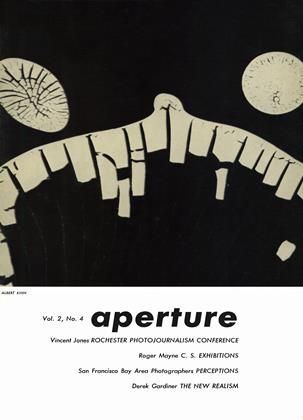THE C. S. EXHIBITIONS
roger mayne
Roger Mayne is the press secretary of the "Combined Societies"a group of Englishmen who, dissatisfied with traditional camera club pictorialism, have established their own exhibitions. C. S. is one of several dissenting groups in Europe to champion creative, personal and experimental photography.
The C. S. Exhibitions were never planned to be the answer to the pictorial salon, they just grew from simple beginnings into their present stature as shows of modern photography. In 1940 Hugo van Wadenoyen was asked to judge the Bristol Salon. Burned before, he asked who his fellow judges would be; for if two were “pictorial” to his one “modern” why judge—he would be outvoted in every instance. When the committee told him to be the sole judge, he said, “upon your head be it.” Then threw out the work by those most eminent pictorialists Alexander Keighley and Marcus Adams. This aroused interest and consternation in the world of R. P. S. photography.
He was invited again, however, to judge the Bristol Salon, then the Hereford and Wolverhampton Salons. When he found many of the same prints in each show, he suggested that the exhibitions be joined and visited to each of the three cities. The traveling exhibition was called the Combined Societies. At that time the exhibition could not be called "modern" as the contributors were mainly camera club members in the pictorial tradition; but glaring examples of fake, plagarism, and false sentiment were ruthlessly banned.
• During the war the shows were supported mainly by British photographers, but at the war’s end it was realized that the international status of the exhibitions could be propagated. So in 1945 the organization was changed, run as an open show of “modern” photography, and called the C. S. Association Exhibition. (The initials were retained for their notoriety.) The exhibition visited other provincial centers beside the original three and the judging panel included non-photographers who were distinguished in some other medium. Sir Herbert Read, the writer and art critic was the first.
The exhibitions have steadily improved as the size of the entry decreased; this year there was very little “dead weight.” This is a welcome change from the early years, when if we had imposed the highest standards there would have been no exhibition at all. I guess the pictorial contributors have found out what kind of a show it is.
• I think that the first reason for having these exhibitions is that we like to see good photographs and assume that there are other people with the same desire. The second reason is that people in general have been woefully misled. So much indifferent and sentimental photography has been passed off as “art” that a real difficulty exists in getting people to realize what a “good” photograph is. We feel that the public frankly needs some help in order to attain a better standard of taste—and that exhibitions of creative photography will help.
To do this the exhibitions must show the best work available each year; which means that the leading photographers of the world must offer their support. On the whole such persons have ceased to be interested in open exhibitions or salons-understandably disinterested because their ideals of truth or beauty are anathema to the sentimentalists.
We need the creative photographs of the leading professionals because their ideals are similar to our own, but we also need the work of the young amateurs who already find that pictorialism is a dull business, and who have ideas of their own. In a way it is for the young amateur that these exhibitions are continued. We wish to hold up for his inspection an ideal that we consider honest and are delighted to provide an outlet for his creative strivings.
I am sure that some of the youngsters are put off by the term we use "modern," thinking that we expect photographs as abstract as some con temporary paintings. Such is not the case. Probably I ought to explain as best I can what we understand by that term. We mean photography that is of its own time. It is truthful, it is personal at times, experimental at times. It is a variety of things actually. Sometimes it grows out of the everyday business of living, the beauty of the commonplace; at other times it grows out of the uncommon and the unusual, it is the beauty of the strange. It is hard to say exactly what we mean by "modern," but we feel that it should come from the heart of the maker.
• I have no fear of photographic abstractions, nor of abstract painting. In fact I feel that photography because it is largely representational when practiced as an art form, can help bridge the too wide gap that exists between abstract painter and public.
The invitation to exhibit with C. S. is open to all, professional itnd ama teur both. We regret that aperture was delayed past the deadline for this year's show; however, for next year entry blanks will be available about February of 1955 from Roger Mayne, 7a Addison Ave., London W. 11. England.
 View Full Issue
View Full Issue
More From This Issue
-

Perceptions
Spring 1954 By Dody Warren -

Rochester Photojournalism Conference 1953
Spring 1954 By Vincent S. Jones -

The New Realism
Spring 1954 By Derek Gardiner -

Notes And Comments
Spring 1954 -
 Editorial
EditorialNew Developments And The Creative Photographer
Spring 1954 By Minor White -

Why Aperture Is Late
Spring 1954


